Sun Jul 26 2020 · 6 min read
Covid-19 in Armenia: Making Sense of the Numbers, Part II
Updated July 25, 2020

By Raffi Kassarjian
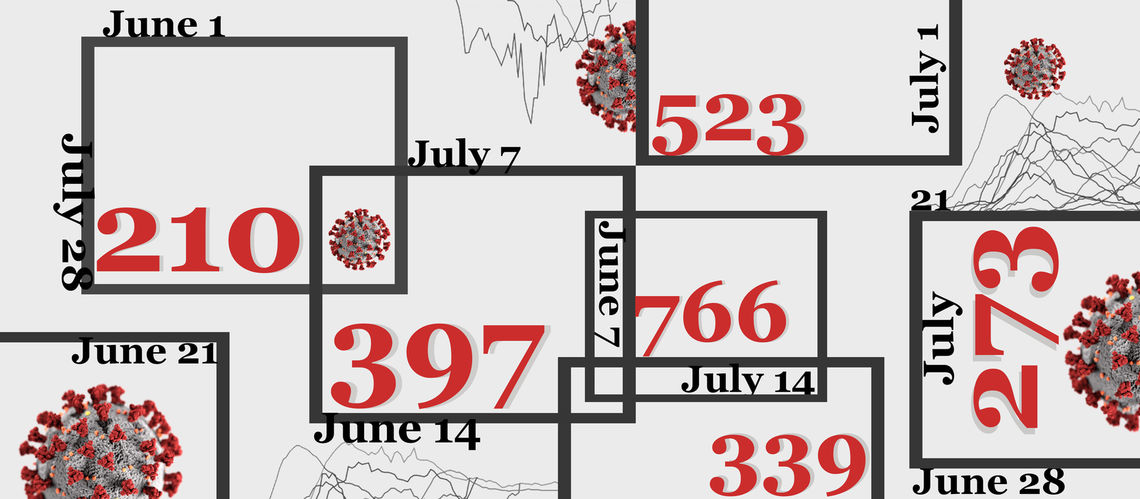
Following the May analysis of the progression of Covid-19 in Armenia compared to the rest of the world (Covid-19 in Armenia), much has changed, both globally and in Armenia. What can we understand about the development of the disease, as well as governments’ efforts to balance managing the progress of the disease with sustaining a minimum level of economic and social activity? In particular, since the numbers in Armenia continue to remain high, and new “flare-ups” and “surges” are being reported in other countries, where do we stand? We will compare Armenia to select other countries on four metrics: number of new daily cases, breadth of testing, number of daily deaths, and case fatality rate. While the first two measures indicate progression of disease (and efficacy of tracing and managing new infections), the last two reflect each country’s ability to treat those seriously affected by the disease.
Number of new daily confirmed cases
While there are several approaches to calculating the progress of the disease, most statistical analyses (as well as government actions/reactions) look at either 7-day or 14-day rolling averages, to smooth out any short-term spikes. Cases and deaths are calculated per million to account for the vast difference in sizes of population by country. We will utilize the 7-day rolling average of new cases per million population, and this is what it looks like for Armenia:
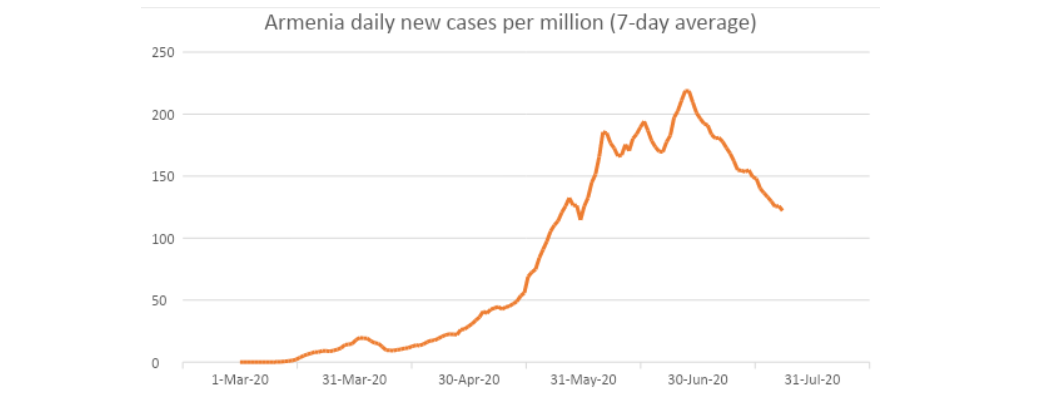
As we can see, Armenia experienced a 4-times increase in number of daily cases from mid-May to the end of June (when Armenia had the dubious honor of being ranked #1 globally), followed by a steady decrease since the beginning of July. However, as the next chart will show, we are still unfortunately at the very top of the list when compared to a number of other countries1:
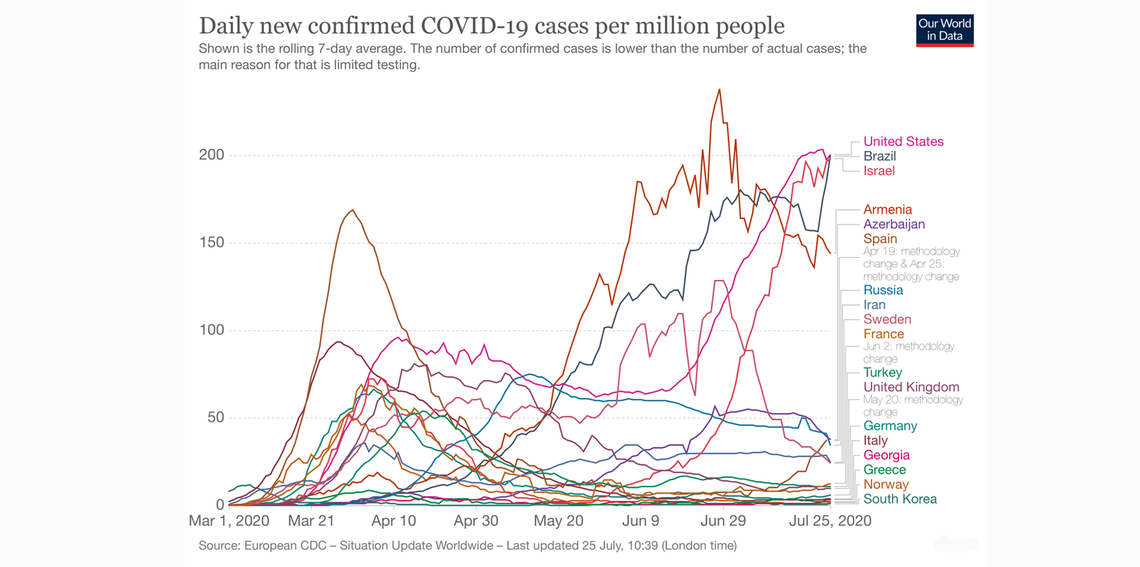
Breadth of Testing
As has been reported many times, the number of confirmed cases does not represent the actual number of those infected, due to a number of factors, including the testing capacity and reach in each country, the number of asymptomatic infected people, and individuals’ reticence to be tested for either social or economic reasons. Most experts agree that the ratio of positive tests to total tests should be under 10% (some say as low as 5%) to ensure a relatively accurate picture of the penetration of the virus in any population. In our review in May, Armenia’s %-positive rate was hovering around 10%, higher than the average of comparison countries. We see a markedly different picture today:
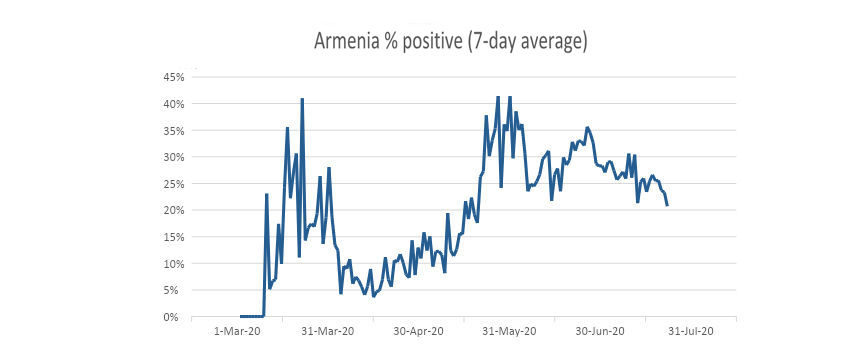
The significant increase of the last two months is due primarily to the fact that testing capacity has remained under 2000 per day while the easing of restrictions on movement and economic activity in early May led to more people coming in contact with each other, leading to an increase in the penetration of the disease. There is a positive trend since the beginning of July. However, as we can see from our analysis of other countries, at 20%, we are significantly behind other countries’ breadth of testing2:

In fact, Brazil is the only country with a higher percentage of positive tests, which reflects the furious outbreak of the disease in that country, and the Brazilian government’s inability to “catch up” with testing.
Deaths per million population
Fatalities are the most visible indication of Covid-19’s direct impact on the population. While Armenia experienced a relatively low number of fatalities per million people at the outset of the outbreak, the trend for daily deaths per million for the past two months is worrisome.
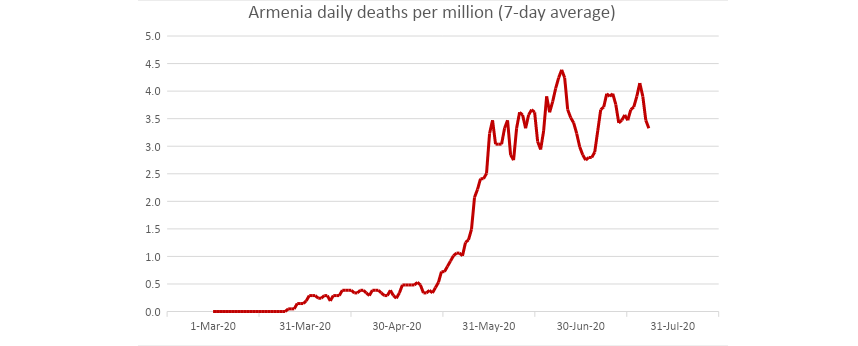
The increase from less than 1 fatality per million per day to 3.5 per million per day is directly correlated to the increased number of confirmed cases. In this respect, while far from the peaks experienced by other countries earlier in the pandemic, Armenia is currently second only to Brazil3, per the following chart:
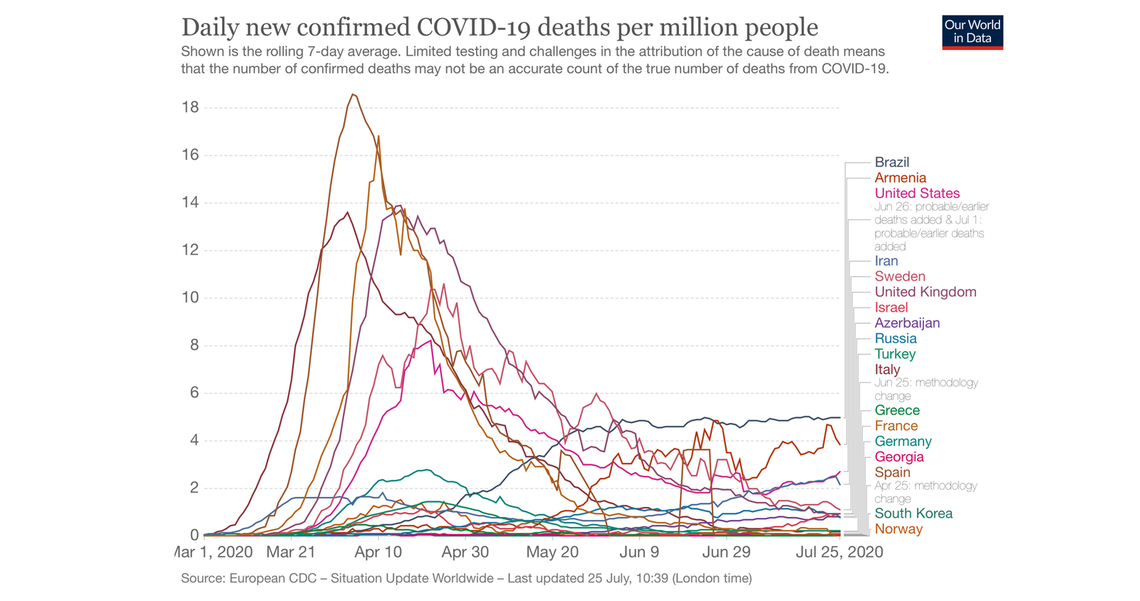
Case fatality rate
While the total fatality rate is a measure of the effectiveness of controlling the spread of the disease, the case fatality rate – which compares the total number of deaths to the total number of confirmed cases – reflects several factors, including the age distribution of the population, prevalence of underlying complicating factors such as cardiovascular disease, and also the ability of the country’s healthcare system to cope with those affected by the pandemic. As we can see, Armenia’s rate has been slowly increasing over the past few weeks, but is still in the lower third of the group of comparison countries:
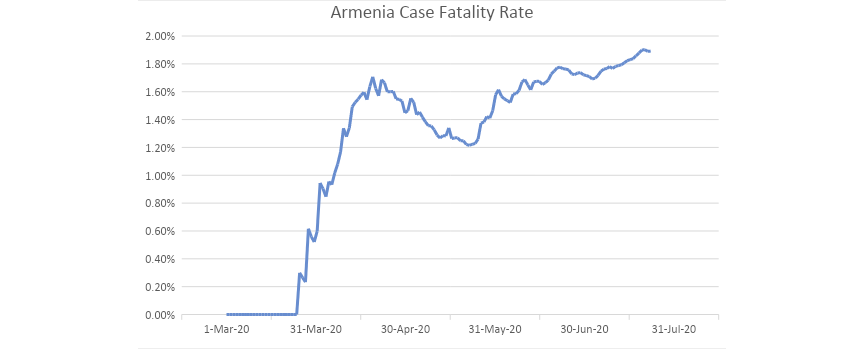
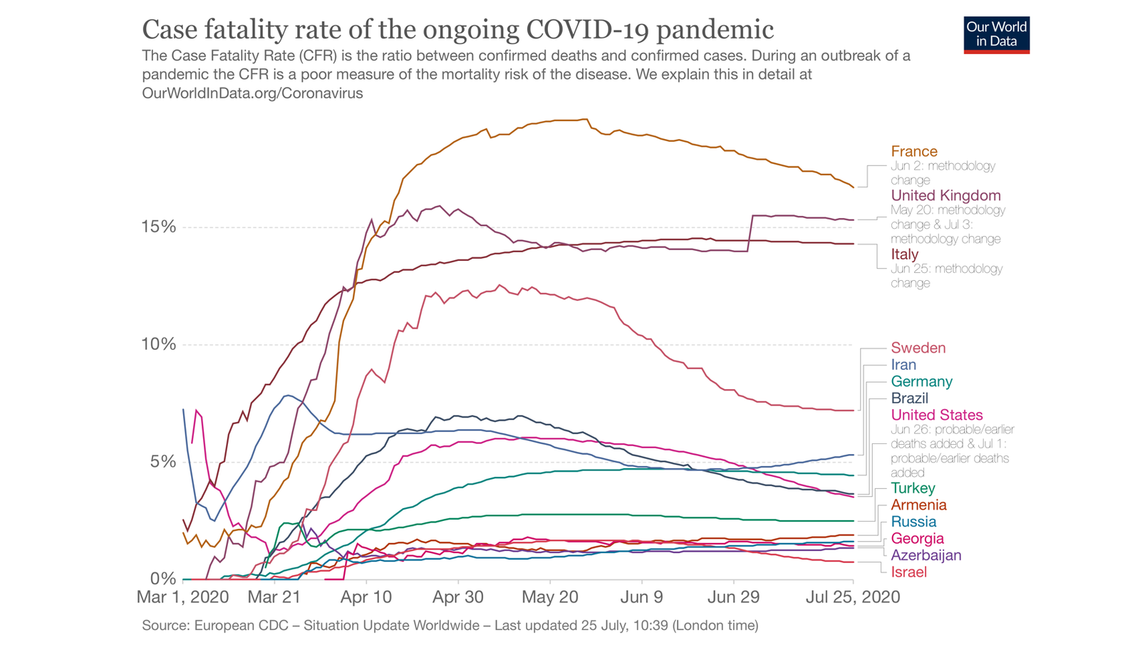
Overall Progress
Since the beginning of the outbreak, governments around the world have tried to maintain a very difficult balance between ensuring that the healthcare system is not overwhelmed by the number of infected patients requiring care and achieving some level of normalcy on economic and social activity. While global public discourse has focused on the number of infections and fatalities, there is very little reporting on the number of confirmed cases who have since recovered. Once we subtract the number of recovered from total confirmed cases, we are left with the number of active cases, some percentage of which are recovering at home, others in regular hospital wards and isolation centers, and the most seriously ill in intensive-care units. In this respect, the picture for Armenia looks stable:
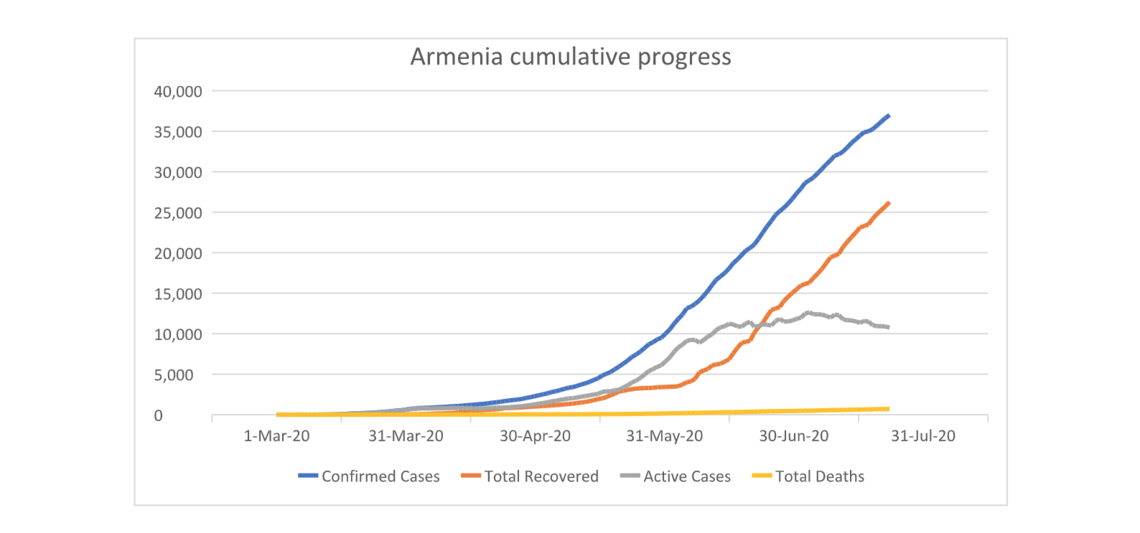
The grey line representing the number of active cases has remained relatively flat, and is now slightly decreasing, which indicates that the continued increase in total number of confirmed cases has not reached a level where the healthcare system is overwhelmed. Of course, this could change if, for example, the number of seriously ill shoots up due to a mutation in the virus, or if there is a short-term spike resulting in a sudden increased demand for hospital and especially ICU beds. Nevertheless, it’s encouraging to see that the demand for healthcare capacity has not surged.
Conclusions
Our ability to effectively manage the course of this pandemic is based on a better understanding of the underlying dynamics of contagion, disease progress and immunity, which in turn informs and drives our collective ability to reduce the spread of the disease, treat those who are infected, and develop responsive measures such as vaccines. In Armenia, the easing of restrictions in early May did lead to an increase in the spread of the virus; however, the blame cannot be placed solely on government policy and level of enforcement. Each organization and each member of society must accept their individual and collective responsibility to help reduce the spread of the disease – after all, the virus is transmitted from individual to individual, and not by acts of government or effectiveness of law enforcement. Therefore, wearing masks, maintaining social distance, washing hands frequently and taking immediate action after developing symptoms are still the most effective measures each of us can take to navigate through this global pandemic.
----------------------------------------
1- Global data from: "Coronavirus Pandemic (COVID-19)". Published online at OurWorldInData.org, as of July 25, 2020. The difference between the Armenia-only data and comparative data on Armenia is that in cases where the daily data from Armenia is not uploaded to the global database, two days are added together, which creates distortion in 7-day averages. The data for Armenia comes directly from the National Center for Disease Control of Armenia (ncdc.am), updated on July 25, 2020.
2- Armenia, as well as a number of other countries are not shown in the comparative chart because the global dataset does not include testing data from certain countries. As per the previous chart, Armenia’s % positive is 25%. It should be noted that the number of negative tests could include test results from previously infected patients who have since recovered, meaning that the actual positive rate of those tested for the first time is higher.
3- Please note that Armenia is 2nd in terms of deaths per day per million; We are 16th for overall (cumulative) deaths per million since the beginning of the pandemic.
also read
Covid-19 in Armenia: Making Sense of the Numbers
By Raffi Kassarjian
Armenia is struggling to find the appropriate balance between health and safety on the one hand, and the threat of severe economic disruption on the other. Raffi Kassarjian looks at the data to understand what is driving the increasing number of cases.
Observations About Armenia’s COVID-19 Response
By Lusine Sargsyan
While it is still early to assess the effectiveness of the Armenian government’s COVID-19 response, Lusine Sargsyan reviews some of the key measures authorities introduced over the past five months.
COVID19: The Story Behind the Numbers
By Ani Avetisyan
Economist Ani Avetisyan takes a closer look at the numbers behind the COVID-19 pandemic.






EVN Report welcomes comments that contribute to a healthy discussion and spur an informed debate. All comments will be moderated, thereby any post that includes hate speech, profanity or personal attacks will not be published.